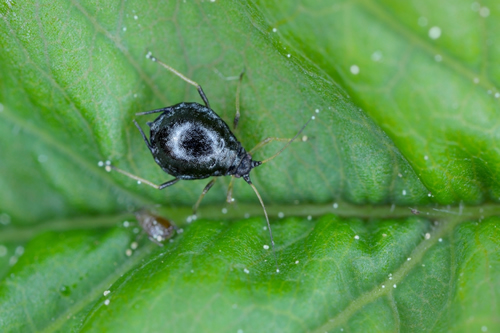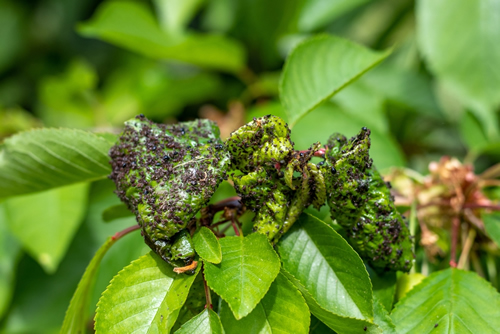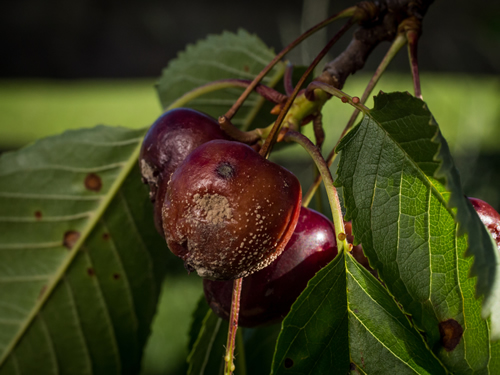A Complete Guide to Pruning the Cherry Tree in the UK
Ah, the cherry tree. A symbol of warmth and abundance in our British gardens. Pruning can be intimidating- but it doesn’t have to be. With a few easy steps, you can ensure your cherry tree remains healthy and abundant year after year by pruning correctly.
In this comprehensive guide we will cover everything you need to know about pruning your cherry trees in the UK; from understanding when to start pruning, to different techniques for long-term success! So, pull up your gardening gloves and let's get started!
Understanding the Basics of Pruning a Cherry Tree in the UK
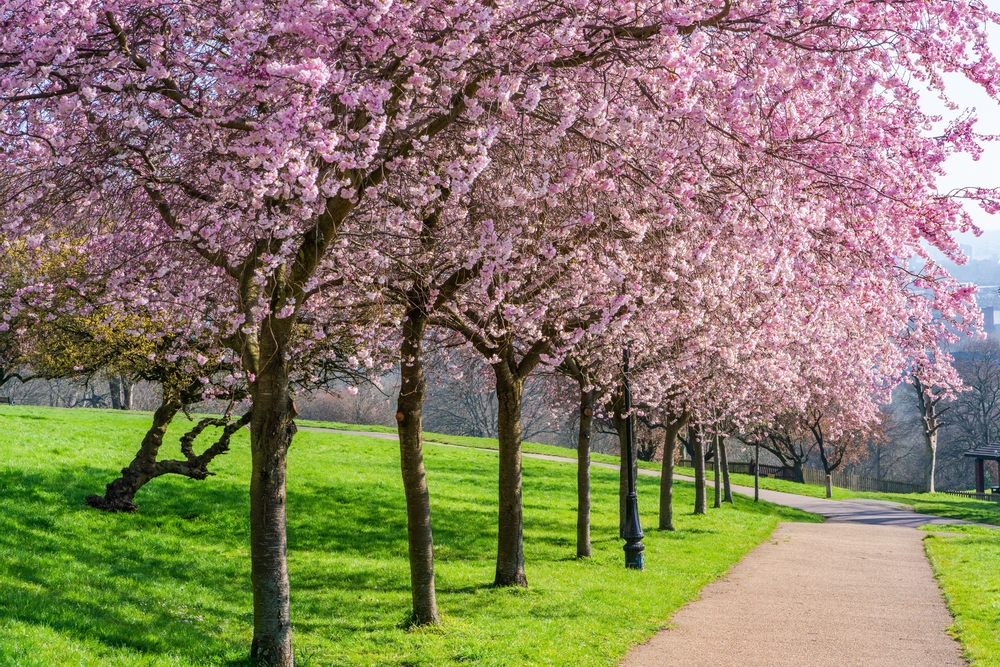
Cherry blossoms in Alexandra Park, London, UK
Pruning a cherry tree might seem like a daunting task, but it's actually essential for the tree's health and productivity. In the UK, it's best to prune the tree during the dormant season, from November to late March.
The first step is to remove any dead, diseased, or damaged branches, as these can be a breeding ground for pests and diseases.
Then, focus on thinning out branches to allow more light to reach the fruit-bearing areas of the tree.
It's important to make clean cuts with sharp tools to avoid damaging the tree, and to avoid over-pruning, which can stunt its growth.
With a bit of patience and practice, anyone can become a proficient cherry tree pruner and enjoy the benefits of a healthier, more productive tree.
A Step by Step Guide on How to Prune a Cherry Tree in the UK
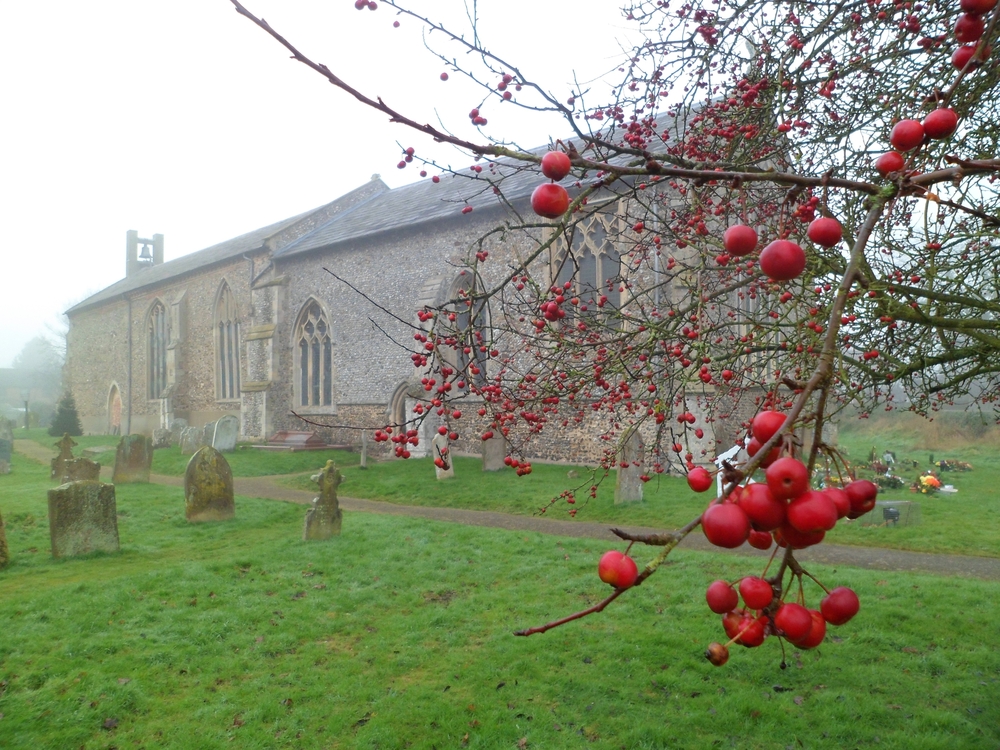
Winter cherries on a churchyard cherry tree (Prunus). Medieval church and graveyard in background. Norfolk, UK.
-
Step 1: Gather the Necessary Tools
Before you begin pruning, ensure you have the following tools:
- A pair of sharp, clean secateurs (pruning shears)
- Loppers for larger branches
- A pruning saw for even larger branches
- A ladder or platform (if necessary)
- Protective gloves and eyewear
Step 2: Assess the Tree's Condition
Start by examining your cherry tree to identify any dead, diseased, or damaged branches. Also, look out for branches that are crossing over one another, growing inward, or congesting the tree's canopy. Make a mental note of which branches need to be removed.
Step 3: Remove Dead, Diseased, or Damaged Branches
Begin pruning by removing any dead, diseased, or damaged branches. This will help prevent the spread of disease and promote overall tree health. Use your secateurs for small branches and loppers or a pruning saw for larger branches. Make clean cuts at a slight angle, about 1-2cm above a healthy bud or side branch.-
Step 4: Prune Crossing or Inward-Growing Branches
Next, remove any branches that are crossing over one another or growing inward toward the tree's center. These branches can create congestion in the tree's canopy, reducing airflow and light penetration, which can lead to a decline in fruit production and overall tree health. Cut these branches back to a healthy outward-facing bud or side branch. -
Step 5: Thin Out the Canopy
To improve light penetration and airflow within the tree, thin out the canopy by removing any excess branches. Aim to create an evenly spaced, open structure with well-distributed branches. Remove no more than 20-25% of the tree's overall canopy in a single pruning session to avoid stressing the tree. -
Step 6: Shorten Long Branches
If you notice any overly long branches, trim them back to encourage a more compact growth habit. Cut these branches back to a healthy bud or side branch, aiming to maintain the tree's overall shape and balance. -
Step 7: Prune for Fruit Production
For cherry trees grown primarily for fruit production, focus on maintaining a strong framework of branches that can support the weight of the fruit. Encourage fruiting spurs by cutting back the previous year's growth on fruiting branches by about one-third. This will stimulate the development of new fruiting wood. -
Step 8: Clean Up
Once you have finished pruning your cherry tree, clean and disinfect your pruning tools to prevent the spread of disease. Gather and dispose of all the pruned branches, taking care not to leave any debris behind, as this can harbor pests and diseases.
By following this step-by-step guide, you'll be able to prune your cherry tree effectively, ensuring its health, beauty, and productivity for years to come. Remember to always prune during the dormant season and practice good hygiene with your tools to minimize the risk of disease.
Preparing for Pruning – Tools You'll Need, and How to Choose Them
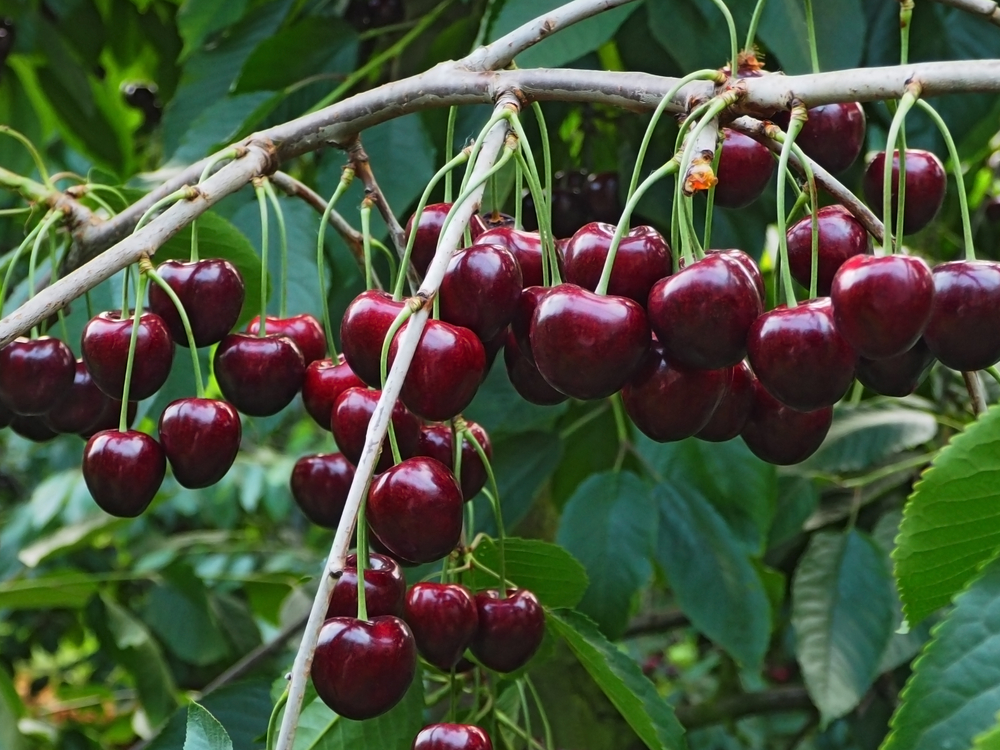
Delicious juicy cherries hanging in the tree
Preparing for pruning your plants can be an easy and efficient task with the right tools in hand. First and foremost, a good pair of pruning shears is essential as they are perfect for cutting branches up to 1 inch in diameter.
However, if you need to remove larger branches, a saw might be necessary. It is important to choose the right type of saw for the job, as some are better for thicker branches while others are better for thinner ones.
Additionally, loppers can be used for branches that are up to 2 inches thick, making them a versatile tool for any gardener. Lastly, invest in a good pair of gloves to protect your hands as well as eyewear to prevent any debris from getting into your eyes. With these tools, you'll be properly equipped to handle any pruning task with ease.
Removing Deadwood, Suckers and Branches – What to Cut and When
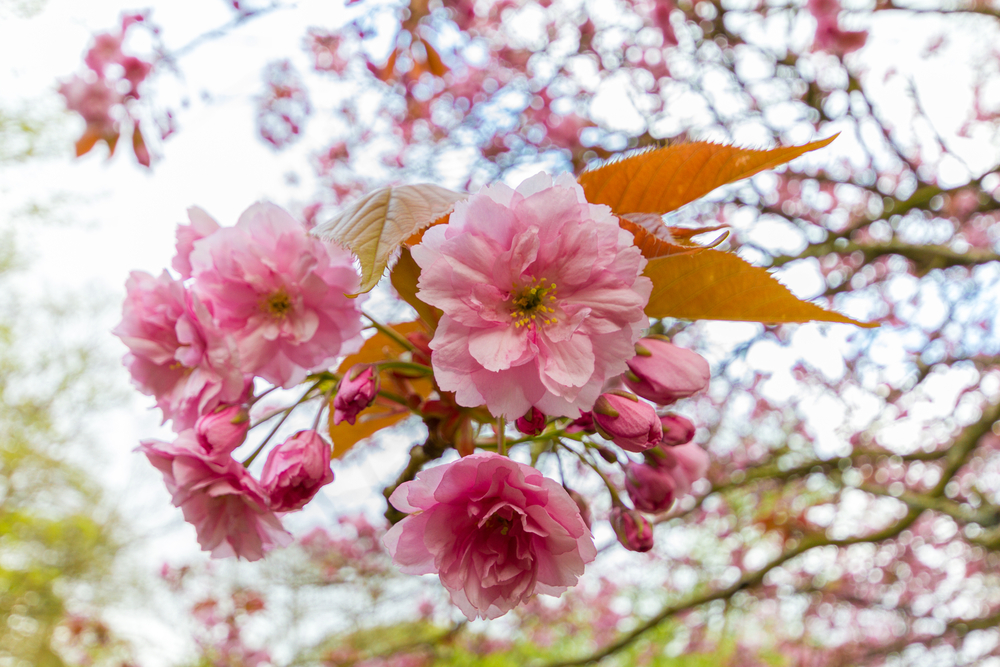
Close-up on the pink blossoms of a prunus serrulata kwanzan cherry tree in Jesmond Dene park in Newcastle, UK shot on an April spring afternoon
Pruning your trees and shrubs may seem like a daunting task, but it's essential for their health and growth. Removing deadwood, suckers, and branches is a vital part of pruning, but knowing what to cut and when can make all the difference.
Deadwood should be removed as soon as possible to prevent disease and insect infestation, while suckers and water sprouts should be removed in the early spring to encourage strong and healthy growth. It's also important to consider the overall shape and structure of the plant, and remove any branches that are crossing or competing with others.
With the right knowledge and tools, pruning can be a rewarding and meditative activity that leads to beautiful, healthy plants.
Enhancing Flowering and Fruiting - Tips on Budding and Spacing Out Branches
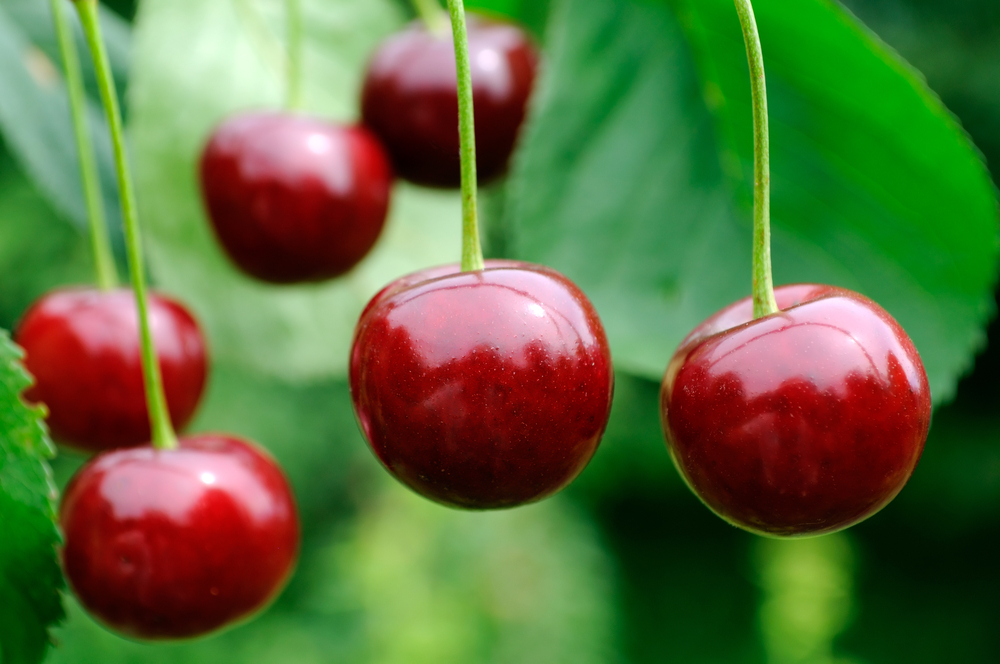 Ripe Cherries on the Cherry Tree, Just Ready to Eat
Ripe Cherries on the Cherry Tree, Just Ready to EatTo get the most out of your garden, understanding ways to enhance flowering and fruiting is crucial. One key aspect is to know how to properly bud and space out branches. By doing so, you can optimize the amount of light, water, and nutrients that each branch receives, which can ultimately lead to higher yields of fruits and flowers. This process involves identifying the strongest branches and removing any weak or unproductive ones, as well as finding the right balance between spacing that allows for maximum sunlight exposure while avoiding overcrowding. With these tips and a bit of patience, you'll be on your way to a bountiful harvest.
Cherry trees typically flower in spring, with the exact timing depending on the variety and local climate. In the UK, cherry blossoms generally appear between late March and early May. However, the blooming period may vary slightly from year to year due to weather conditions and other environmental factors.
If your cherry tree does not flower, there could be several reasons:
-
Age:
Young cherry trees may take a few years to establish themselves and start flowering. Generally, cherry trees begin to produce blossoms after 3-5 years, depending on the variety and growing conditions. -
Insufficient sunlight:
Cherry trees require plenty of sunlight to bloom and produce fruit. If your tree is planted in a shaded area, it may not receive enough sunlight to trigger flower production. -
Improper pruning:
Over-pruning or pruning at the wrong time of year can reduce the number of flower buds and negatively impact flowering. Ensure you follow proper pruning techniques and prune during the dormant season (between November and early March in the UK). -
Nutrient imbalance:
A lack of essential nutrients, particularly phosphorus and potassium, can affect your cherry tree's ability to flower. Conduct a soil test to determine if nutrient deficiencies are an issue and amend the soil accordingly. -
Weather conditions:
Unusual weather patterns, such as a late frost or sudden temperature fluctuations during the flowering period, can damage flower buds and prevent the tree from blooming. -
Disease or pest issues:
Certain diseases or pests can cause damage to the tree, resulting in a lack of flowering. Inspect your tree for any signs of disease or infestation and treat accordingly.
To encourage your cherry tree to flower, ensure it receives adequate sunlight, proper pruning, and appropriate nutrients. Additionally, monitor the tree's health and address any potential issues promptly. With the right care, your cherry tree should eventually produce beautiful blossoms and fruit.
Aftercare - Watering, Mulching and Feeding the Tree for Optimum Growth
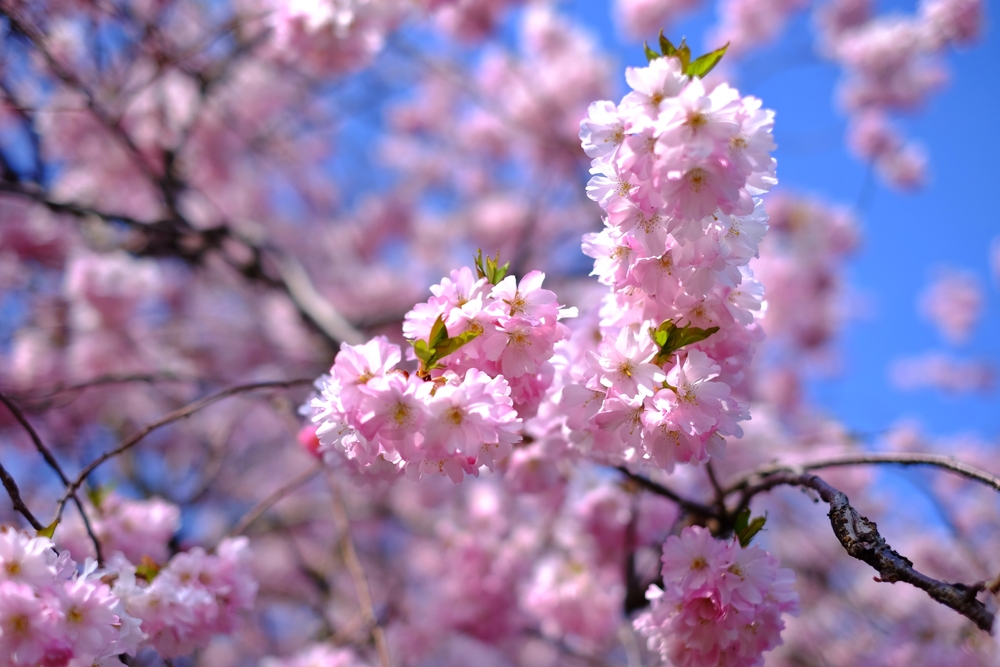
Cherry Blossom
Taking care of your trees doesn't stop after planting them. Proper aftercare is essential to ensure optimum growth. This includes watering, mulching, and feeding the tree.
Watering should be done regularly, especially during the first few years of growth, to ensure that the roots receive enough moisture.
Mulching can help retain moisture and also regulate soil temperature. It also helps prevent weed growth, which can compete with the tree for nutrients and water.
Feeding the tree with the right nutrients promotes growth and helps fight off pests and diseases.
Aftercare may require a little more time and effort, but it is worth it as it ensures a healthy and thriving tree for years to come.
Mulch and compost are both excellent additions to a garden as they can help retain moisture, suppress weeds, and feed the soil with essential nutrients. Here are some different types of mulch and compost that you can use after pruning to ensure healthy growth:
Types of Mulch
- Wood Chips: Wood chips are a common type of mulch and are useful for suppressing weeds and retaining moisture. They also slowly break down over time, releasing nutrients into the soil.
- Pine Needles: Pine needles are acidic and can be used as mulch around acid-loving plants such as azaleas and blueberries. They also decompose slowly, making them a long-lasting option.
- Straw: Straw is an excellent mulch for vegetable gardens, as it is low in nutrients but retains moisture well. It can also help suppress weeds.
- Shredded Leaves: Shredded leaves are a natural and free mulch that many gardeners use in their gardens. They add organic material to the soil as they decompose, and they also help suppress weeds.
Types of Compost
- Kitchen Compost: Kitchen compost is made from food scraps and other organic waste generated in the kitchen. It is an excellent source of nutrients and can be added to garden beds to enrich the soil.
- Manure Compost: Composted animal manure is a rich source of nutrients, making it an excellent addition to garden soil. However, it should be well-composted before use to avoid burning plants.
- Leaf Compost: Leaf compost is created by decomposing leaves and plant matter and can be used on its own or added to garden soil. It is rich in nutrients and also helps improve soil structure.
- Vermicompost: Vermicompost is made from worm castings and is one of the richest sources of plant nutrients. It can be added to garden soil or used as a potting mix for houseplants.
By incorporating different types of mulch and compost into your garden after pruning, you can help promote healthy growth and improve the overall health of your plants. Always choose high-quality, organic materials to ensure the best results.
To ensure healthy growth and fruit production, cherry trees require proper nutrition. When choosing a fertilizer for your cherry tree, consider one that provides a balanced mix of essential nutrients. Here is a list of some of the best fertilizers for cherry trees:
-
Granular slow-release fertilizers:
A balanced granular slow-release fertilizer with an N-P-K ratio (Nitrogen-Phosphorus-Potassium) of 10-10-10 or 14-14-14 is an excellent option for cherry trees. These fertilizers release nutrients gradually over an extended period, providing consistent nutrition throughout the growing season. -
Organic compost:
Incorporating well-rotted organic compost or well-aged manure into the soil around your cherry tree can significantly improve soil structure and provide essential nutrients. Organic compost also benefits the soil by promoting beneficial microorganisms and improving water retention. -
Fish emulsion:
Fish emulsion is an organic liquid fertilizer that provides a rich source of nitrogen, phosphorus, and potassium. It is easily absorbed by the roots and can be applied as a foliar spray or drenched into the soil. -
Bone meal:
Bone meal is an organic fertilizer that is high in phosphorus, which promotes root development and flowering. Mix it into the soil around your cherry tree to promote strong root growth and improve blossom production. -
Potassium sulfate:
Potassium sulfate is a synthetic fertilizer that provides a concentrated source of potassium, an essential nutrient for fruit development and overall plant health. Apply potassium sulfate to the soil around your cherry tree to support fruit production and overall vigor. -
Balanced liquid fertilizers:
Liquid fertilizers are fast-acting and can be applied directly to the soil or as a foliar spray. Choose a balanced liquid fertilizer with an N-P-K ratio similar to granular slow-release fertilizers (such as 10-10-10) for best results.
When applying fertilizer to your cherry tree, always follow the manufacturer's instructions for recommended rates and application methods. It's also essential to conduct a soil test to determine the specific nutrient requirements of your tree and amend the soil accordingly. Proper fertilization will support your cherry tree's overall health, promote flowering, and boost fruit production.
A Complete Guide to Caring for Cherry Trees in the UK
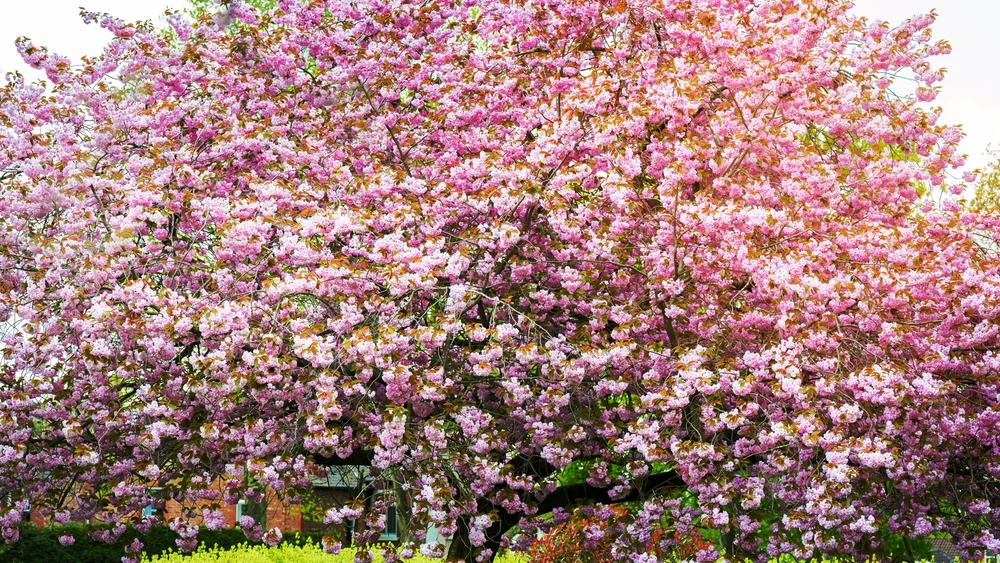
Pink Cherry Trees in Bloom in the Park during Spring Season
Springtime in the UK is a beautiful spectacle, and one of the most memorable sights during this season is the blooming of cherry trees. With their bright pink and white flowers enlivening your garden, it's no surprise why so many people want to grow them!
However, caring for cherry trees can be complex - if you don't know what you're doing they could quickly become unpredictable or even dead. So for those looking to get into cultivating these majestic flowering wonders, we've created this comprehensive guide to ensure that your cherry tree will continue to thrive each year.
From understanding soil composition to pruning correctly and everything else in between, by following along here you'll be well on your way towards getting the best out of your new trophy specimen!
Overview of Cherry Trees - What They Are and How They Grow in the UK
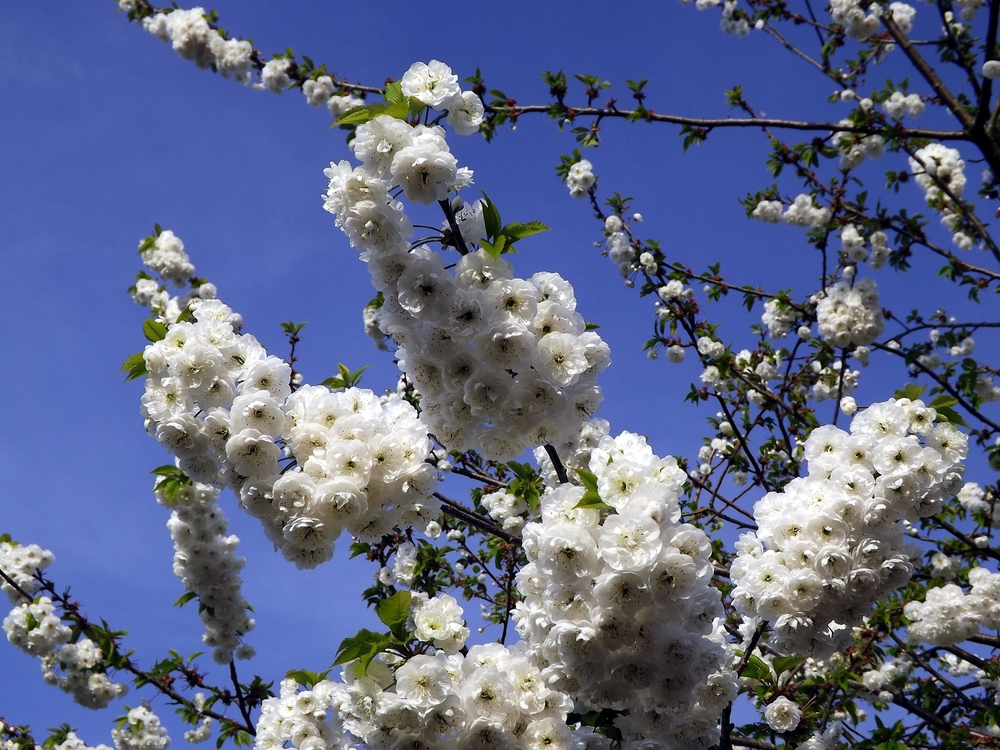
A flowering cherry tree covered in beautiful white blossom on a sunny Spring day in Milton Keynes, UK. Flowers covering a tree. New leaves growing. City street scene in Springtime. May 2015.
Cherry trees are a beautiful and popular addition to gardens across the United Kingdom. These deciduous trees can grow to be quite large, with broad canopies and delicate pink or white blossoms that bloom in the early spring. Their fruit, which is usually a deep red colour, ripens in the summer months and is harvested by both people and wildlife alike. Cherry trees typically grow in soils that are well-draining and rich in nutrients, and they require ample sunlight in order to thrive.
While they can be somewhat vulnerable to diseases and pests, especially when grown in crowded or damp conditions, proper care and attention can help them to remain healthy and vibrant for many years. So whether you're an experienced gardener or a novice, consider planting a cherry tree and enjoy the beauty and bounty it provides.
The History of Cherry Trees in the UK
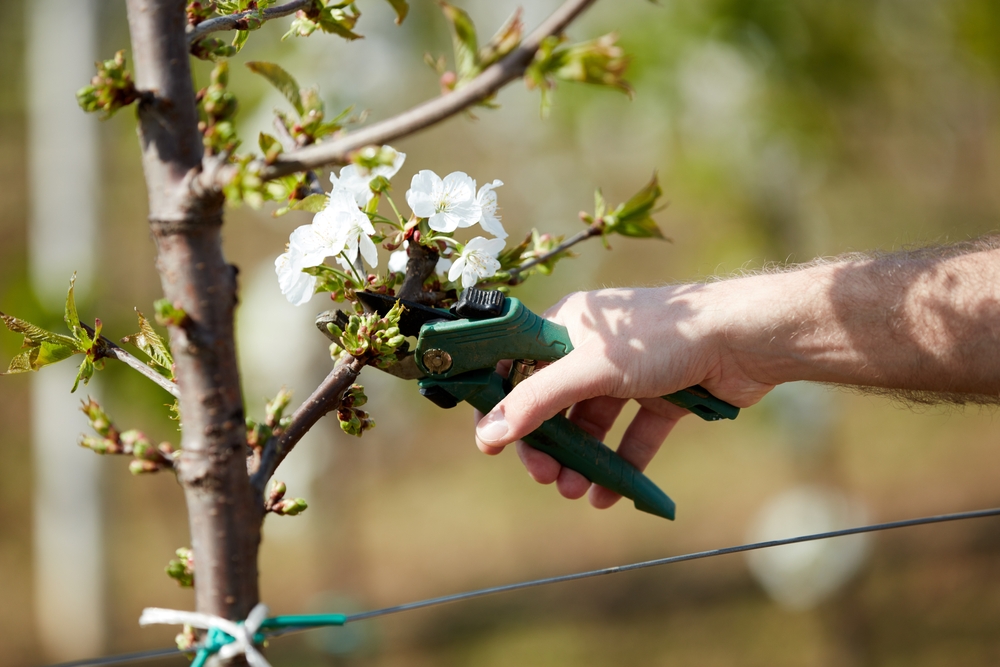
Farmer pruning cherry trees and branches of young trees during blossom in spring
Cherry trees have a rich and fascinating history in the UK. The first record of cherry trees being grown in Britain dates back to the Roman era, when they were introduced to the country.
Over time, the cultivation of cherries became increasingly popular, particularly during the Tudor and Stuart periods. Not only were they used for their delicious fruit, but cherry blossom also became a symbol of beauty and elegance.
Today, the UK boasts some stunning cherry blossom displays, with cities such as London and Edinburgh hosting annual festivals celebrating these beautiful trees. From their ancient origins to their modern-day celebrations, cherry trees have truly left their mark on British history.
The Best Time to Plant a Cherry Tree
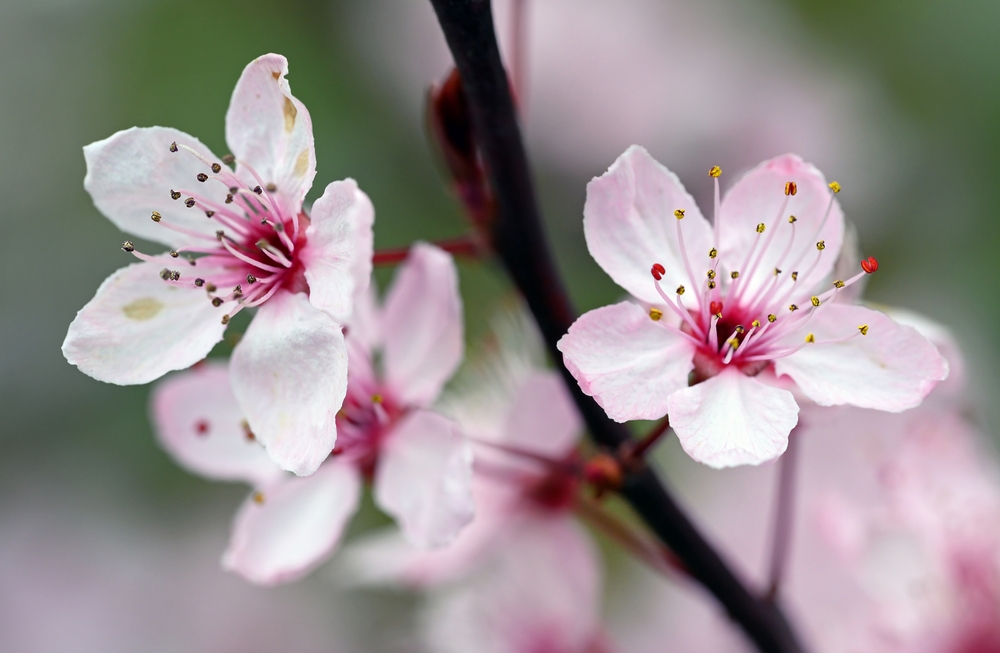
Cherry blossom in bloom. Close up of cherry blossom flowers. Macro photography of pink cherry blossom in Beckenham, Kent, UK
The best time to plant a cherry tree is during the late autumn or early winter months when the tree is dormant. This allows the roots to establish themselves before spring growth starts.
It is important to choose a sunny spot that is well-draining, as cherry trees prefer full sunlight and moist but not waterlogged soil. Proper planting techniques are also crucial for the longevity and health of the tree.
By planting a cherry tree at the optimal time and in the right location, you can look forward to enjoying the beautiful blossoms and delicious fruit for years to come.
Choosing the Best Location to Plant a Cherry Tree

Branch of ripe cherries on a tree in a garden
Choosing the best location for planting a cherry tree is essential for its healthy growth and development. Cherry trees require a suitable environment, including adequate sunlight exposure, nutrient-rich soil, and protection from strong winds.
When selecting a location, consider the tree's growth and take into account the mature size of the cherry tree. You'll want to ensure the location provides enough space for the tree's roots to stretch out and access water and nutrients.
Choose a spot that is away from other trees or structures, as the cherry tree may require more space as it grows older. Remember, cherry trees are long-term investments, so picking the right location can ensure a fruitful harvest for years to come.
How to Prepare the Soil for Planting a Cherry Tree
Planting a cherry tree can be a beautiful addition to any garden or backyard. However, before you start digging, it's important to prepare the soil properly.
The first step is to assess the quality of the soil and its drainage. Cherry trees prefer well-draining soil with a pH level between 6.0 and 6.5. Once you've determined that the soil is suitable, it's time to dig a hole that is twice as wide and just as deep as the tree's root ball. Loosen the soil at the bottom of the hole and incorporate a good quality compost or manure to improve the soil's fertility.
Avoid planting cherry trees too deeply as this can compromise their root system. With proper soil preparation and planting, you can enjoy a bounty of delicious cherries year after year.
Getting to Know Your Tree - Identifying the Different Types of Cherry Trees
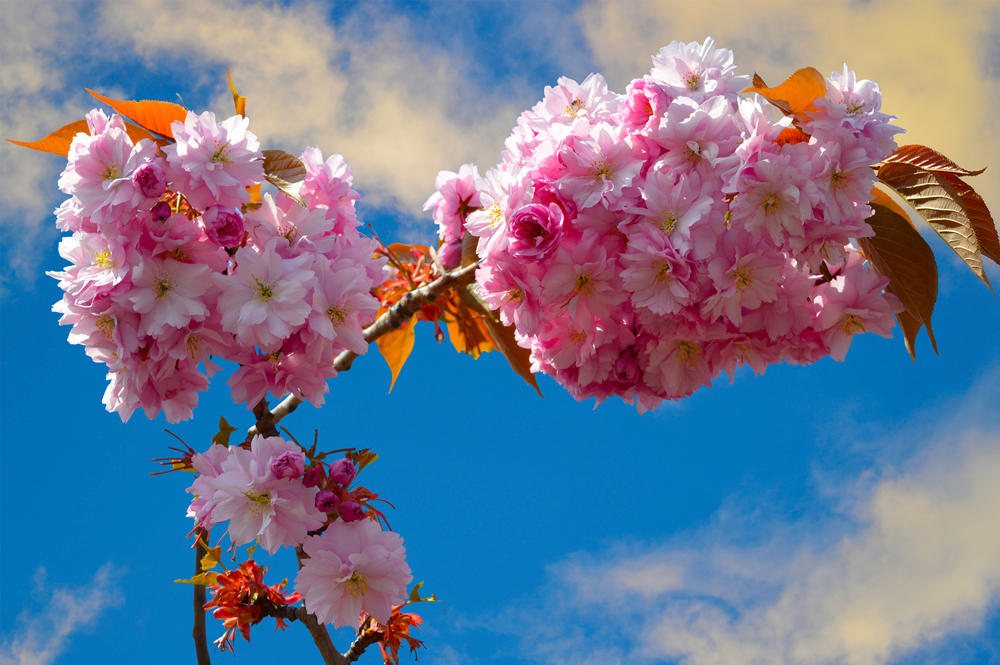
Japanese flowering cherry Latin name Prunus Kanzan
As you stroll through a park, you may notice beautiful pink blossoms on some trees and juicy cherries on others. But do you know what type of cherry tree you're looking at? Identifying the different types of cherry trees is an interesting and informative way to understand more about the trees in your environment.
There are various types of cherry trees, each with their unique features such as flower shape, bloom time, and fruit appearance. Knowing these characteristics can help you appreciate the beauty of cherry trees even more and recognize them when you see them. Whether you're a nature lover, gardener, or just curious about trees, learning about the different types of cherry trees is an enjoyable and enriching pastime.
Choosing the Right Species of Cherry Tree for Your Garden
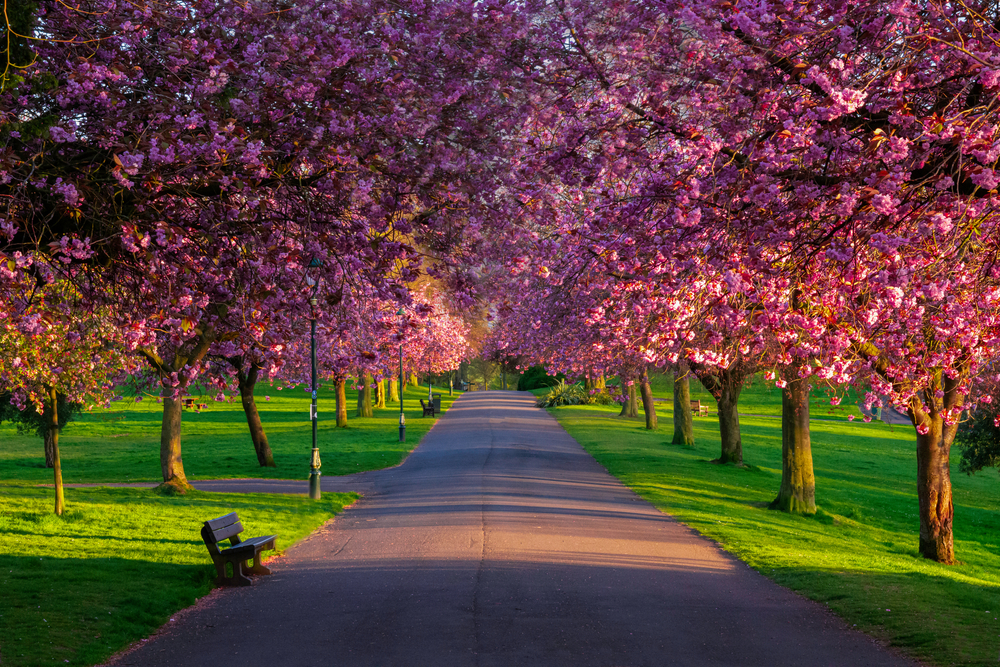
Avenue of cheery blossom trees in Pittencrieff park, Dunfermline, fife, Scotland, uk.
Cherry trees are a beautiful addition to any garden, but choosing the right species can be tricky. If you want a tree with show-stopping flowers, the Yoshino cherry is a great choice. Its delicate pink blooms are a sight to behold in the springtime. If you're looking for a tree that produces fruit, the sweet cherry is a go-to option. These trees bear mouthwatering fruit in the summertime, perfect for pies and jams. Another great species to consider is the sour cherry, which is not only great for cooking but also blooms with pretty pink flowers. Whatever your preference, choosing the right species of cherry tree will add a burst of colour and life to your garden.
In the UK, there are several cherry tree varieties available, each with distinct features and characteristics. Here's a list of some popular cherry tree varieties and a brief passage on each:
-
Stella
- Stella is a self-fertile, sweet cherry variety that is well-suited for the UK climate. It produces large, dark red cherries with a firm texture and excellent flavor. As a self-fertile tree, it doesn't require a pollination partner, making it an ideal choice for smaller gardens or those with limited space. -
Sunburst
- Sunburst is another self-fertile cherry tree variety known for its large, sweet, and juicy fruits. The cherries produced by this tree have a deep black color, and the tree itself has a relatively compact growth habit. Sunburst cherries are perfect for eating fresh, cooking, or preserving. -
Lapins
- Lapins is a Canadian cherry variety that is well-adapted to the UK climate. This self-fertile tree produces large, dark red cherries with a sweet and slightly tart flavor. Lapins cherries have a firm texture, making them suitable for both fresh eating and culinary uses. -
Morello
- Morello is a sour cherry variety that is often used for cooking and preserving. This self-fertile tree produces small, dark red cherries with a tangy flavor. Morello cherries are perfect for making jams, pies, and sauces. The tree is also known for its attractive white spring blossoms and autumn foliage. -
Sweetheart
- Sweetheart is a late-season, self-fertile sweet cherry variety. It produces large, heart-shaped cherries with a deep red color and a sweet, rich flavor. The fruits have a firm texture, making them suitable for both fresh eating and cooking. The tree has a relatively compact growth habit and is well-suited for smaller gardens. -
Merton Glory
- Merton Glory is an early-season, sweet cherry variety that produces large, light-colored cherries with a mild, sweet flavor. This tree requires a pollination partner, so it's essential to plant another compatible cherry tree nearby. Merton Glory is known for its heavy cropping and attractive white blossoms in spring. -
Regina
- Regina is a late-season sweet cherry variety that produces large, dark red fruits with a firm texture and excellent flavor. This tree requires a pollination partner, so planting another compatible cherry tree nearby is necessary. Regina cherries are suitable for both fresh eating and culinary uses.
Which is the Best Fruit Producing Cherry Trees
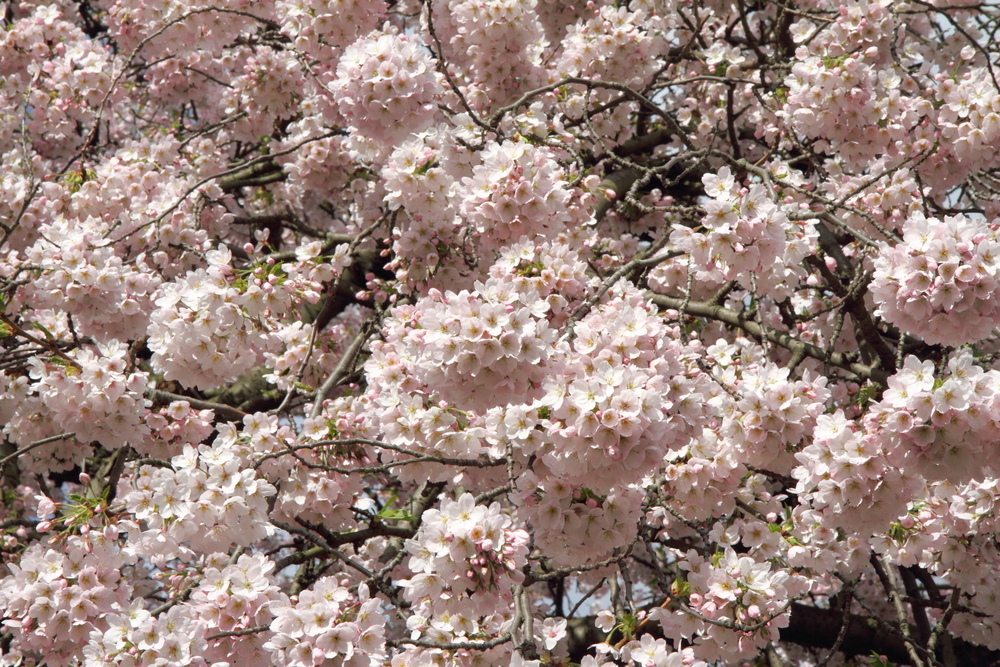
Cherry tree blooming flowers
Cherries are a delicious addition to any summer fruit bowl or dessert, but did you know there are different varieties of cherry trees that produce varying levels of sweetness and texture? Some of the best fruit producing cherry trees include the Bing, Rainier, and Stella cherries. Bing cherries are known for their deep red color and sweet, juicy flavor, while Rainier cherries are a bit milder in taste and have a slightly yellow hue. The Stella cherries, on the other hand, are known for their heartiness and resistance to disease. No matter which variety you choose, enjoying fresh cherries straight from the tree is sure to be a delightful treat for your taste buds.
Determining the "best" fruit-producing variety of cherry trees depends on your personal preferences, climate, and garden conditions. However, one of the most popular and reliable sweet cherry varieties for fruit production is the Stella cherry tree.
Stella is considered a top choice for several reasons:
-
Self-fertility:
Stella is a self-fertile cherry tree, meaning it doesn't require a pollination partner to produce fruit. This makes it an excellent option for smaller gardens or those with limited space. -
Adaptability:
Stella is well-suited to the UK climate and can tolerate a range of growing conditions, making it a reliable choice for fruit production. -
Fruit quality:
Stella produces large, dark red cherries with a firm texture and excellent flavor, making them enjoyable for fresh eating. -
Disease resistance:
This variety is relatively resistant to common cherry tree diseases, which contributes to its consistent fruit production. -
Attractive appearance:
In addition to producing delicious fruit, Stella cherry trees also offer beautiful white blossoms in spring, adding ornamental value to your garden.
While Stella is a popular choice, it's essential to consider your specific needs and preferences when selecting the best fruit-producing cherry tree for your garden. Factors such as available space, desired fruit characteristics, and climate should all be taken into account.
Pests and Diseases which Effect the Cherry Tree
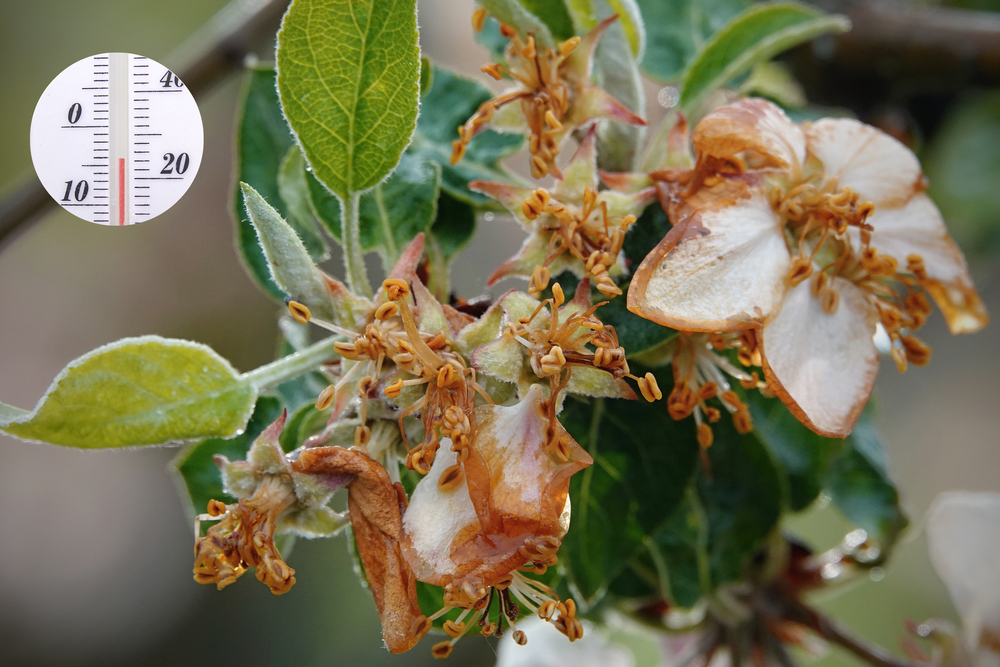
Flowers of a fruit tree affected by spring frost( -4˚ C).
The cherry tree is a beautiful addition to any garden or yard, but it requires some maintenance to keep it healthy. Unfortunately, pests and diseases can take a toll on the tree, threatening its growth and productivity.
Some of the most common pests that affect cherry trees are Aphids, fruit flies, and Spider Mites, which can all cause considerable damage if left unchecked.
Diseases, like cherry Leaf Spot and bacterial canker, can also weaken the tree and make it susceptible to other threats. To keep your cherry tree healthy and fruitful, it's essential to monitor it regularly and take necessary action if you spot any signs of trouble. With proper care and attention, you can ensure a bountiful harvest of delicious, juicy cherries for years to come.
Cherry trees can be affected by a variety of pests and diseases. Here's a list of some common issues and a brief passage on each:
-
Aphids:
Aphids are small, sap-sucking insects that can infest cherry tree leaves and stems. They can cause stunted growth, curled leaves, and reduced fruit production. Aphids also excrete a sticky substance called honeydew, which can encourage the growth of sooty mold. To control Aphids, consider introducing natural predators like ladybirds, using insecticidal soap, or applying neem oil. -
Cherry Leaf Spot:
Cherry Leaf Spot is a fungal disease that causes small, purple-Black Spots on the leaves, eventually leading to leaf yellowing and premature leaf drop. Severe infections can reduce fruit yield and weaken the tree. To manage cherry Leaf Spot, practice good sanitation by removing infected leaves and debris, maintain proper pruning to improve airflow, and apply a fungicide if necessary. -
Powdery Mildew:
Powdery Mildew is a fungal disease that appears as a white, powdery coating on the leaves, shoots, and sometimes fruit. It can cause leaf distortion, reduced fruit quality, and weakened trees. To control Powdery Mildew, maintain proper pruning for good airflow, avoid excessive nitrogen fertilization, and apply a fungicide if needed. -
Bacterial Canker:
Bacterial canker is a serious disease caused by the bacterium Pseudomonas syringae. It results in sunken, dark lesions on the branches and trunk, gum oozing, and wilting of leaves. Infected trees may die if not treated promptly. To manage Bacterial Canker, prune and destroy infected branches, maintain good tree health, and apply copper-based bactericides during the dormant season. -
Cherry Fruit Fly:
The cherry fruit fly is a small fly that lays its eggs in developing cherries. The larvae feed on the fruit, causing it to become soft, discolored, and unmarketable. To control cherry fruit flies, use yellow sticky traps to monitor their presence, apply insecticides when needed, and practice good sanitation by removing infested fruit from the tree and ground. -
Birds:
Birds, such as starlings and blackbirds, can cause significant damage to cherry crops by pecking at the fruit. To protect your cherry tree from birds, consider using bird netting, reflective tape, or other bird deterrents. -
Silver Leaf Disease:
Silver Leaf Disease is a fungal infection that causes a silver sheen on the leaves, branch dieback, and eventual tree death if left untreated. To prevent Silver Leaf Disease, avoid pruning during the wet season, make clean pruning cuts, and remove and destroy infected branches.
By monitoring your cherry tree for signs of pests and diseases and taking appropriate action, you can maintain its overall health and ensure a bountiful harvest. Regularly inspect your tree, practice good sanitation, and provide proper care to minimize the risk of pest and disease problems.
Watering Requirements and Fertilizing Schedules
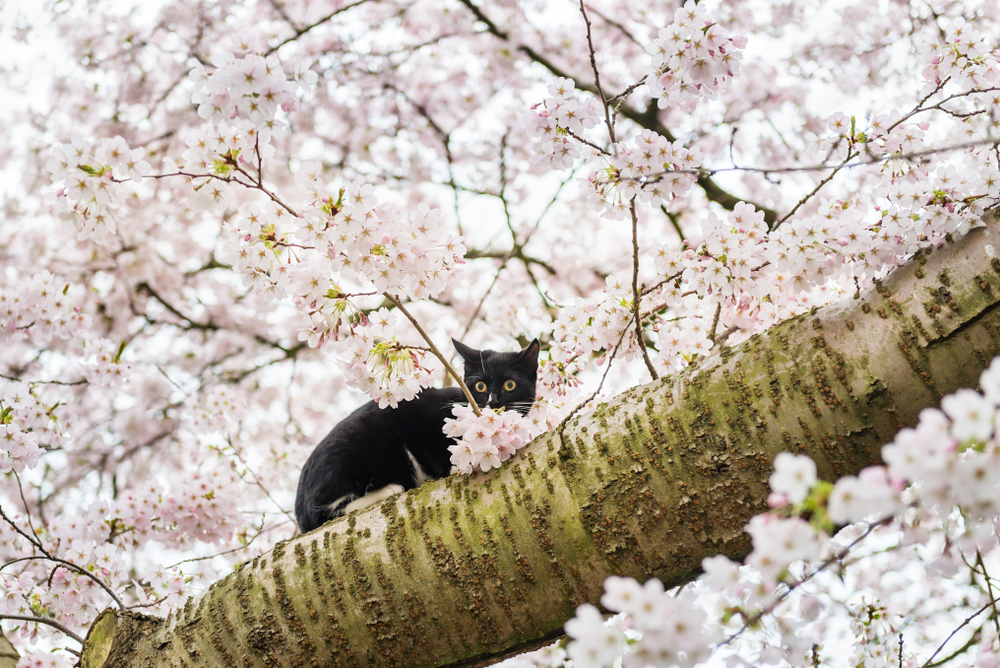
Cat is sitting on a White Blossom Cherry Tree during Spring Season
As a gardener, it's important to know when to water and fertilize your plants in order to keep them healthy and thriving. Different plants have varying watering requirements and fertilizing schedules, so it's important to research and learn about the specific needs of each plant in your garden.
Over watering can lead to Root Rot and other issues, while under watering can cause wilting and stress.
Fertilizer provides essential nutrients for plant growth, but excessive use can lead to burning and damage. By understanding the watering requirements and fertilizing schedules of each individual plant, you can ensure a bountiful and beautiful garden.
The Best Propagation Methods for the Cherry Tree
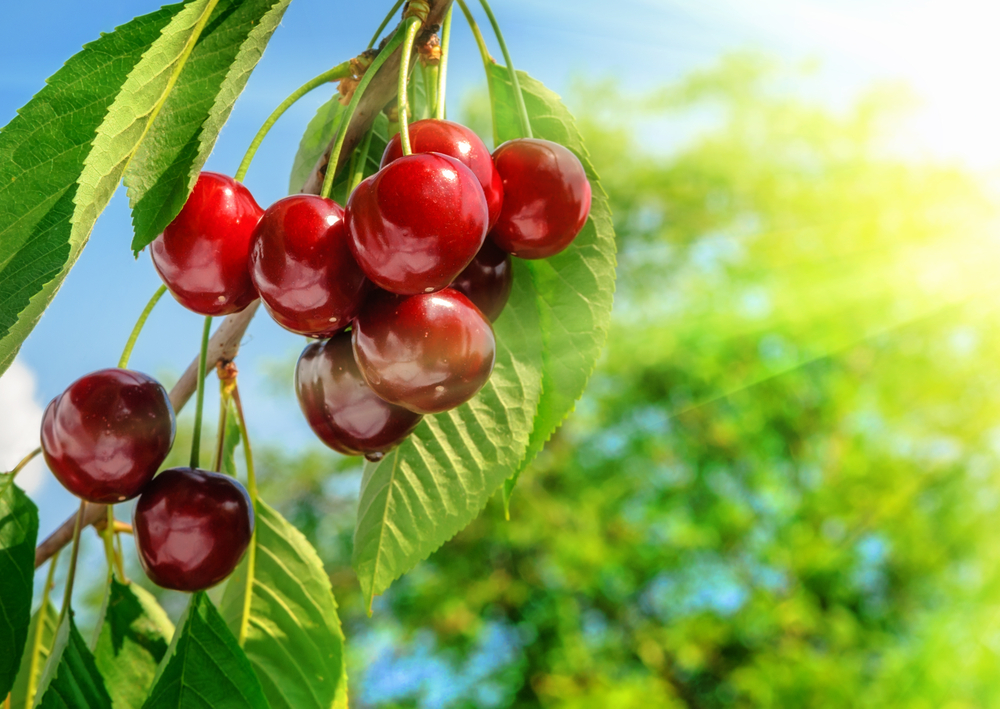
Red and sweet cherries on a branch just before harvest in early summer
Cherry trees are a beautiful addition to any garden or backyard. To ensure the best growth and health of the tree, it is essential to choose the right propagation method. The most common methods are grafting, cuttings, and layering.
Grafting is a technique that involves combining two different types of cherry tree to create a hybrid, resulting in a stronger and more resilient plant.
Cuttings involve clipping a branch of the tree and encouraging new roots to grow, which can be time-consuming but ultimately more cost-effective.
Layering is another method that involves bending a branch into the soil and allowing it to grow new roots, resulting in a clone of the original tree.
By choosing the right propagation method for your cherry tree, you can help ensure it thrives and becomes a beautiful centerpiece in your outdoor space.
Step by Step Guide on How to Graft a Cherry Tree
Grafting is a horticultural technique used to join two plants together, typically by attaching a shoot (scion) from one plant to the rootstock of another. Grafting cherry trees allows you to combine the desired fruiting characteristics of one variety with the rootstock's beneficial traits, such as disease resistance and controlled growth. Here's a step-by-step guide on how to graft a cherry tree:
-
Step 1: Gather the Necessary Tools
Before you begin grafting, ensure you have the following tools:- A sharp grafting knife or scalpel
- Pruning shears or a saw (for preparing the rootstock)
- A scion (the desired cherry tree variety)
- Rootstock (compatible with your chosen scion)
- Grafting tape or rubber bands
- Grafting wax or sealant
- Protective gloves and eyewear
-
Step 2: Choose the Right Time
The best time to graft cherry trees is during the dormant season, typically between late winter and early spring (February to March in the UK). At this time, both the scion and rootstock are dormant, but the sap will soon start flowing, promoting successful graft union. -
Step 3: Prepare the Scion
Select a healthy scion from the desired cherry tree variety. The scion should be a one-year-old shoot, about 6-8 inches (15-20 cm) long and pencil-thick. Cut the scion just before grafting to ensure it remains fresh. Trim the base of the scion into a wedge shape with two even, sloping sides using your grafting knife.
When grafting a cherry tree, it's important to choose the right rootstock that complements the scion (the desired fruiting variety). Rootstocks determine factors such as tree size, vigor, disease resistance, and adaptability to soil conditions. There isn't a single "best" rootstock for all cherry tree scions, as the ideal choice depends on your specific needs and growing conditions.
Here are some common cherry tree rootstocks and their characteristics:
-
Gisela 5:
This dwarfing rootstock is popular for its precocity (early fruiting), high yield potential, and good compatibility with most sweet cherry varieties. Gisela 5 is suitable for small gardens and high-density plantings, as it produces trees that are about 50-60% of standard cherry tree size. -
Gisela 6:
Gisela 6 is a semi-dwarfing rootstock that results in trees around 70% of standard size. It offers good adaptability to various soil types, early fruit production, and compatibility with many sweet cherry varieties. Gisela 6 is an excellent choice for medium-sized gardens or orchards. -
Colt:
Colt is a semi-vigorous rootstock that produces trees about 80-90% of standard size. It is known for its good adaptability to a range of soil types and climates, moderate precocity, and compatibility with most sweet cherry varieties. Colt rootstock also provides some resistance to bacterial canker, making it suitable for areas prone to this disease. -
Mazzard:
Mazzard is a standard-sized, vigorous rootstock that produces full-sized cherry trees. It is compatible with most sweet cherry varieties and is well-suited to larger gardens or orchards. Mazzard rootstock is adaptable to various soil types but may take longer to start fruiting compared to dwarfing or semi-dwarfing rootstocks. -
Mahaleb:
Mahaleb rootstock is used primarily for sour cherry varieties. It produces trees that are about 75% of standard size and adapts well to various soil types, including light, well-drained soils. Mahaleb rootstock is compatible with most sour cherry varieties but is not recommended for sweet cherries.
-
-
Step 4: Prepare the Rootstock
Choose a suitable rootstock that is compatible with your chosen scion. The rootstock should be a healthy, well-established plant with a trunk diameter similar to the scion. Remove any side shoots or branches from the rootstock using your pruning shears or saw. -
Step 5: Choose a Grafting Technique
There are several grafting techniques suitable for cherry trees, such as whip-and-tongue graft, cleft graft, and T-bud graft. For this guide, we'll focus on the whip-and-tongue graft:- Make a sloping cut about 1-2 inches (2.5-5 cm) long on the top of the rootstock using your grafting knife. The cut should be at a similar angle to the wedge-shaped base of the scion.
- Make a second downward cut into the center of the first cut, creating a small tongue about one-third of the way down.
- Align the scion's wedge with the rootstock's sloping cut, ensuring that the cambium layers (the thin green layer beneath the bark) of both the scion and rootstock make good contact.
- Slide the scion's wedge into the rootstock's tongue, interlocking the two pieces.
-
Step 6: Secure the Graft
Once the scion and rootstock are aligned and interlocked, secure the graft by wrapping it tightly with grafting tape or rubber bands. This will help hold the scion and rootstock together and maintain proper cambium contact. -
Step 7: Seal the Graft
Apply grafting wax or sealant to the graft union and any exposed cuts to prevent moisture loss and protect the graft from pests and diseases. Ensure all cut surfaces are completely covered. -
Step 8: Care for the Grafted Tree
After grafting, place the grafted tree in a sheltered location, protected from strong winds and direct sunlight. Keep the soil moist but not waterlogged. Monitor the graft closely and remove any new growth from the rootstock to direct energy into the scion.
Once the scion starts to grow and the graft union has healed (usually after a few weeks), you can remove the grafting tape or rubber bands. Continue to care for the grafted tree, providing proper watering, fertilization, and pruning as needed.
Growing a cherry tree from a cutting
Growing a cherry tree from a cutting is a cost-effective way to propagate new trees with the same characteristics as the parent plant. Here's a step-by-step guide on how to grow a cherry tree using a cutting:
-
Step 1: Gather the Necessary Tools and Materials
Before starting, make sure you have the following items:
- A sharp pruning shears or knife
- A healthy cherry tree for taking cuttings
- Rooting hormone powder or gel
- A pot or container with drainage holes
- Sterilized potting mix or a combination of perlite and peat moss
- A plastic bag or clear plastic dome
- A spray bottle for misting
-
Step 2: Choose the Right Time
The best time to take cuttings from a cherry tree is during the dormant season, typically between late fall and early winter. This helps ensure the cutting has enough stored energy to develop roots and increases the chances of successful propagation. -
Step 3: Take the Cutting
Select a healthy, disease-free branch from the cherry tree that is about pencil-thick and has several leaf nodes. Cut a section about 6-8 inches (15-20 cm) long, making a straight cut just below a leaf node. Remove all leaves from the lower half of the cutting, leaving only the top 2-3 leaves intact. -
Step 4: Apply Rooting Hormone
Dip the bottom 1-2 inches (2.5-5 cm) of the cutting in rooting hormone powder or gel. This will help stimulate root development and increase the chances of successful propagation. -
Step 5: Prepare the Potting Mix
Fill a pot or container with sterilized potting mix or a mixture of equal parts perlite and peat moss. Moisten the mix thoroughly, ensuring it is damp but not waterlogged. -
Step 6: Plant the Cutting
Make a hole in the potting mix using a pencil or your finger, deep enough to accommodate the bottom third of the cutting. Insert the cutting into the hole, ensuring that the treated end is in contact with the potting mix. Gently firm the mix around the cutting to provide support and eliminate air pockets. -
Step 7: Create a Humid Environment
Cover the pot with a plastic bag or clear plastic dome to create a humid environment that promotes root development. Make sure the plastic does not touch the cutting's leaves, as this can lead to rot. -
Step 8: Place the Cutting in a Suitable Location
Put the cutting in a warm, bright location, out of direct sunlight. A temperature of around 68-75°F (20-24°C) is ideal for cherry cuttings. Monitor the cutting regularly to ensure the potting mix remains moist but not waterlogged, and mist the cutting with water as needed to maintain humidity. -
Step 9: Check for Root Development
After 4-6 weeks, gently tug on the cutting to check for resistance, which indicates root development. Alternatively, you can carefully remove the cutting from the potting mix and inspect the base for roots. -
Step 10: Transplant the Rooted Cutting
Once the cutting has developed a healthy root system, transplant it into a larger pot filled with well-draining, fertile potting soil. Continue to care for the young cherry tree by providing adequate water, nutrients, and sunlight. After the tree has grown strong enough and the risk of frost has passed, you can transplant it to its final location outdoors.
By following this step-by-step guide, you can successfully propagate a cherry tree from a cutting, creating a new tree with the same characteristics as the parent plant. With proper care and attention, your cherry tree will grow and thrive, providing delicious fruit for years to come.
This blog post has provided an extensive overview of the necessary steps in pruning a cherry tree, from getting to know your tree to understanding the basics and requirements for aftercare. Pruning is all about giving the cherry tree an opportunity to reach its highest potential, without becoming overburdened or stressed. While it may take patience and practice to get comfortable with this art form, there’s no better way to ensure long-term growth and fruit production than through proper pruning practices. When done right, pruning can make a tremendous difference in the health of a cherry tree, so don’t be afraid to give it a go—it’s well worth it!
To conclude, planting a cherry tree in the UK is an excellent way to enjoy a stunning display of blossoms along with sweet and juicy cherries. When selecting the right cherry tree for your garden, consider its location, size, fruit production and its susceptibility to pests and diseases. Planting will involve preparing the soil and choosing a good variety for your soil type. You can propagate cherry trees by using either the seed or from cuttings method. Watering requirements are important for keeping your cherry tree healthy. Lastly, fertilizing schedules should also be taken into account in order to ensure that your tree has access to all of the essential nutrients for optimum growth over time. Ultimately, giving your cherry Tree the proper care can produce years of enjoyment from this magnificent fruiting addition to any landscape!
How to Prune Climbing Vines
List by Variety
- How to Prune Actinidia
- How to Prune Akebia
- How to Prune Bougainvillea
- How to Prune Campsis
- How to Prune Celastrus
- How to Prune Chilean Glory Vine
- How to Prune Clematis Armandii
- How to Prune Clematis Montana
- How to Prune Climbing Rose
- How to Prune Hedera GoldHeart
- How to Prune Honeysuckle
- How to Prune Hydrangea Petiolaris
- How to Prune Ivy
- How to Prune Japanese Wisteria
- How to Prune Morning Glory
- How to Prune Parthenocissus
- How to Prune Persian Ivy Hedera Colchica
- How to Prune Schisandra
- How to Prune Star Jasmine
- How to Prune Sweet Peas
- How to Prune True Jasmine
- How to Prune Virginia Creeper
- How to Prune Wisteria
How to Prune Hedges
List by Variety
- How to Prune an Arborvitae Hedge
- How to Prune a Barberry Hedge
- How to Prune a Beech Hedge
- How to Prune a Boxwood Hedge
- How to Prune a Butterfly Bush Hedge
- How to Prune a Cotoneaster Hedge
- How to Prune an English Lavender Hedge
- How to Prune an Escallonia Hedge
- How to Prune an Euonymus-Hedge
- How to Prune a Firethorn Hedge
- How to Prune a Forsythia Hedge
- How to Prune a Griselinia Hedge
- How to Prune a Hawthorn Hedge
- How to Prune a Holly Hedge
- How to Prune a Hornbeam Hedge
- How to Prune a Laurel Hedge
- How to Prune a Leylandii Hedge
- How to Prune a Lilac Hedge
- How to Prune a Maple Leaf Viburnum Hedge
- How to Prune a Photinia Hedge
- How to Prune a Pink Ramanus Rose Hedge
- How to Prune a Privet Hedge
- How to Prune a Pyracantha Hedge
- How to Prune a Spirea Hedge
- How to Prune a Thuja Hedge
- How to Prune a Viburnum Hedge
- How to Prune a Western Red Cedar Hedge
- How to Prune a Yew Hedge
How to Prune Shrubs
List by Variety
- How to Prune an Abelia Shrub
- How to Prune an Abutilon
- How to Prune an Acer / Japanese-Maple
- How to Prune an Amelanchiers
- How to Prune an Apple-Tree
- How to Prune an Arbovitae Shrub
- How to Prune an Arbutus
- How to Prune an Aucuba
- How to Prune a Azalea Mollis
- How to Prune Azaleas
- How to Prune a Bay Tree Shrub
- How to Prune a Berberis Darwinii
- How to Prune Berberis Deciduous Types
- How to Prune a Boxwood Shrubs
- How to Prune a Brachyglottis Senecio
- How to Prune a Buddleia Alternifolia
- How to Prune Buddleias Butterfly Bushes
- How to Prune a Buddleja Globosa
- How to Prune a Callicarpa
- How to Prune a Camellia
- How to Prune a Caryopteris
- How to Prune a Catalpa Bignonioides Aurea
- How to Prune Ceanothus Deciduous Types
- How to Prune Ceanothus Evergreen Types
- How to Prune a Ceratostigma
- How to Prune a Chaenomeles
- How to Prune a Choisya
- How to Prune a Cistus
- How to Prune a Clematis
- How to Prune a Cornus
- How to Prune a Cotinus Royal Purple
- How to Prune a Cytisus Scoparius
- How to Prune a Exochorda x Macrantha
- How to Prune a Forsythia
- How to Prune a Hebe
- How to Prune a Hydrangeas
- How to Prune Juniper Shrubs
- How to Prune a Lavatera
- How to Prune Lilac Bushes
- How to Prune a Mugo Pine
- How to Prune Rose Bushes
- How to Prune Spirea Shrubs
- How to Prune Viburnum Shrubs
- How to Prune a Weigela
- How to Prune a Yew
How to Prune Trees
List by Variety
- How to Prune a Apple Tree
- How to Prune a Apricot Tree
- How to Prune a Ash Tree
- How to Prune a Birch Tree
- How to Prune a Cherry Tree
- How to Prune a Elm Tree
- How to Prune a Fig Tree
- How to Prune a Grape Tree
- How to Prune a Hickory Tree
- How to Prune a Maple Tree
- How to Prune a Oak Tree
- How to Prune an Olive Tree
- How to Prune a Peach Tree
- How to Prune a Pear Tree
- How to Prune a Plum Tree
- How to Prune a Poplar Tree
- How to Prune a Walnut Tree
Pests and Diseases
- How to Protect from Anthracnose
- How to Protect from Athids
- How to Protect from Apple Scab
- How to Protect from Armillaria Root Rot
- How to Protect from Bagworms
- How to Protect from Black Knot
- How to Protect from Black Rot
- How to Protect from Black Spot
- How to Protect from Botryosphaeria Dieback
- How to Protect from Botrytis Blight
- How to Protect from Brown Rot
- How to Protect from Canker Diseases
- How to Protect from Caterpillars
- How to Protect from Cedar Apple Rust
- How to Protect from Clematis Wilt
- How to Protect from Codling Moths
- How to Protect from Crown Gall
- How to Protect from Crown Rot
- How to Protect from Downy Mildew
- How to Protect from Dutch Elm Disease
- How to Protect from Elm Bark Beetle
- How to Protect from Elm Leaf Beetle
- How to Protect from Fire Blight
- How to Protect from the Gypsy Moth Caterpillars
- How to Protect from Honey Fungus
- How to Protect from Japanese Beetles
- How to Protect from Juniper Scale
- How to Protect from Lace Bugs
- How to Protect from Lacewings
- How to Protect from Leaf Miners
- How to Protect from Leaf Spot Diseases
- How to Protect from Mealybugs
- How to Protect from Needle Blight
- How to Protect from Oak Borers
- How to Protect from Oak Wilt
- How to Protect from Olive Knot Disease
- How to Protect from Peach Leaf Curl
- How to Protect from Peach Scab
- How to Protect from Pear Psylla
- How to Protect from Pear Rust
- How to Protect from Pear Scab
- How to Protect from Perennial Canker
- How to Protect from Pine Sawflies
- How to Protect from Pine Shoot Beetle
- How to Protect from Plum Fruit Moth
- How to Protect from Plum Pox Virus
- How to Protect from Poplar Borer
- How to Protect from Powdery Mildew
- How to Protect from Root Rot
- How to Protect from Rose Rosette Disease
- How to Protect from Rust Fungi
- How to Protect from Scale Insects
- How to Protect from Silver Leaf Disease
- How to Protect from Slugs
- How to Protect from Spider Mites
- How to Protect from Twig Blight
- How to Protect from Verticillium Wilt
- How to Protect from Viburnum Beetle
- How to Protect from Vine Weevil
- How to Protect from Walnut Blight
- How to Protect from Walnut Husk Fly
- How to Protect from Walnut Scale
- How to Protect from Western Flower Thrips
- How to Protect from Whiteflies
Popular Pruning Sections

General Pruning
General Information on How to Prune your Garden
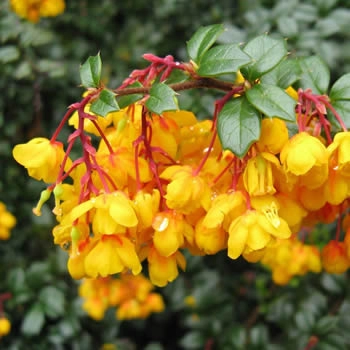
Pruning Shrubs
The Most Read Shrubs to Prune
- How to Prune Hydrangeas
- How to Prune a Rose Bush
- How to Prune Azaleas
- How to Prune a Lilac Bush
- How to Prune Buddleias - Butterfly Bushes
- How to Prune Forsythia
- How to Prune Weigela
- How to Prune Hebe
- How to Prune Camellia

Pruning Trees and Climbers
The Most Read Trees to Prune
- How to Prune Apple Trees
- Pruning Plum Trees
- Pruning Cherry Trees
- Pruning Olive Trees
- How to Prune a Grape Vine
- Acer Pruning | Pruning Japanese Maple
- How to Prune a Fig Tree
- Pruning Peach Trees
- Pruning Pear Trees
- How to Prune a Plum Tree

